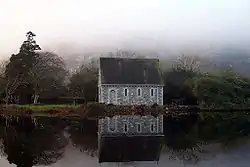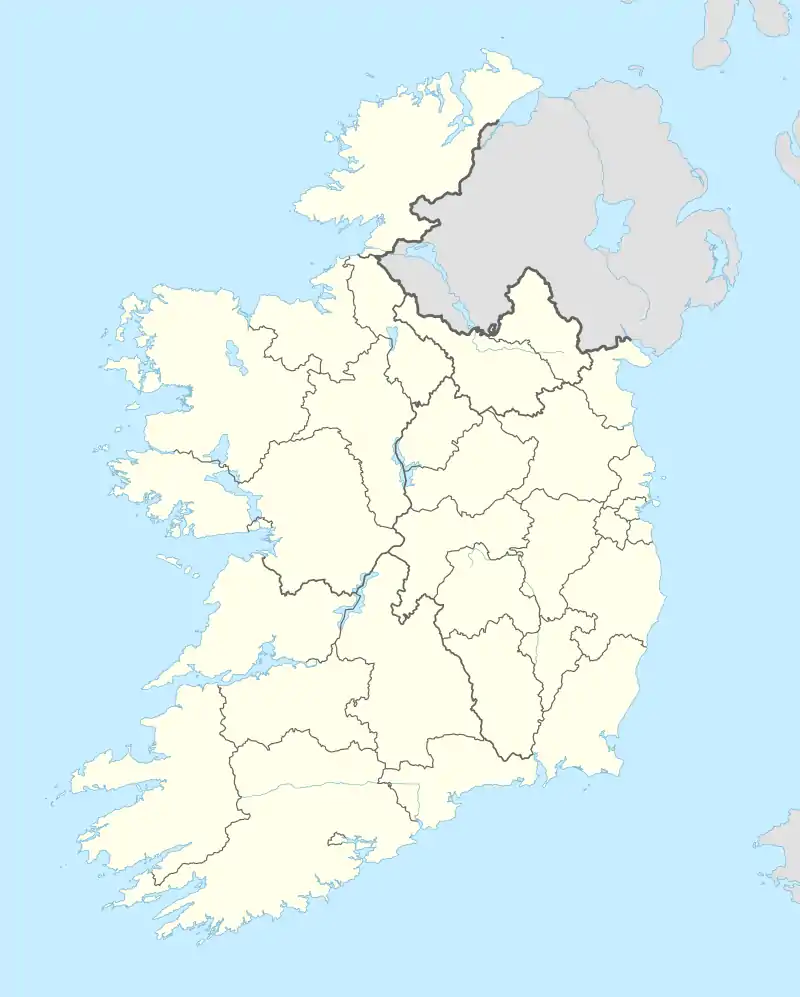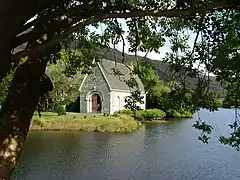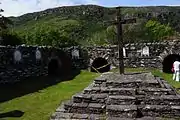Gougane Barra
Gougane Barra (Irish: Guagán Barra, meaning "the rock of Barra")[1] is a settlement, west of Macroom in County Cork, Ireland.
Gougane Barra
Guagán Barra | |
|---|---|
Settlement | |
 Church at Gougane Barra - built on island near monastery/well site at end of 19th century. | |
 Gougane Barra Location in Ireland | |
| Coordinates: 51°50′20″N 09°19′09″W | |
| Country | Ireland |
| Province | Munster |
| County | County Cork |
| Time zone | UTC+0 (WET) |
| • Summer (DST) | UTC-1 (IST (WEST)) |
History
The name Gougane Barra comes from Saint Finbarr, who is said to have built a monastery on an island in the lake nearby during the 6th century. The present ruins date from around 1700 when a priest called Denis O'Mahony retreated to the island.[2] During the times of the Penal Laws, Gougane Barra's remoteness meant that it became a popular place for the celebration of the Roman Catholic Mass. The nineteenth century oratory which stands near the original monastery is famous for its picturesque location and richly decorated interior and is a popular place for wedding photography.[3][4] St Finbar's Oratory is the final destination for one of the five Pilgrim Paths of Ireland, St. Finbar's Pilgrim Path, which starts 35-kilometres away in Drimoleague.[5]
Today
Afforestation around the settlement began in 1938 and Gougane Barra is now home to a 1.42 square kilometre (or 138 hectare) forest park with 20 different species of tree, mainly Sitka spruce, Japanese larch, Scots pine and Lodgepole pine, and a large number of native species of flora and fauna. The source of the River Lee rises in the hills above the park and flows into Gougane lake. The forest park has 5 km of motor trail and 10 km of hill walks, nature points and vista trails.[6] The Coillte-owned forest at Gougane Barra was temporarily closed in 2014 to allow felling of 16,000 trees, mostly larches, infected with or susceptible to Phytophthora ramorum, a pathogen responsible for Sudden Oak Death. These trees were to be replaced with other species such as oak and Scots pine.[7]
Gallery
 Front of the oratory
Front of the oratory Surrounding hills
Surrounding hills 19th century oratory
19th century oratory 18th century hermitage
18th century hermitage
References
- "Guagán Barra/Gougane Barra". Logainm.ie. Retrieved 25 May 2017.
- Evelyn Bolster (1972). A History of the Diocese of Cork: From the earliest times to the Reformation. Irish University Pres. p. 13. ISBN 9780064905725.
Gougane did not become a popular pilgrim venue until about the year 1700 when Father Denis O'Mahony [came to the area]
- "Uibh Laoire Website". Uibhlaoireparish.com. Retrieved 25 May 2017.
- "Gougane Barra". Cork Guide Web site. Retrieved 26 November 2017.
- "St Finbarr's Pilgrim Path, Cork". Pilgrim Paths of Ireland. Retrieved 3 June 2019.
In West Cork and South Kerry the practice of walking pilgrim paths to St Finbarr’s hermitage in Gougane Barra has been in place for many centuries. One such path leads from Drimoleague, where – local tradition has it – St Finbarr arrived at the Top of the Rock in the sixth century and admonished the people to return to Christ, before making his way to Gougane Barra.
- "National and Forest Parks - Gougane Barra Forest Park". DiscoverIreland.ie. Archived from the original on 7 January 2014.
- Roche, Barry (4 January 2014). "Cork's Gougane Barra Forest Park closing due to tree fungus". Irish Times. Retrieved 14 May 2018.